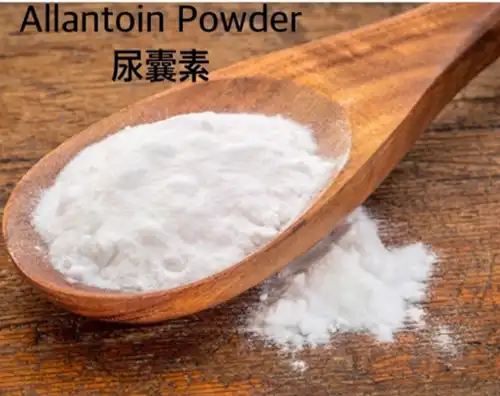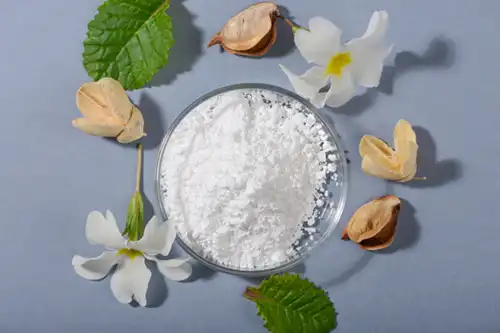How to Use Allantoin Powder on Face?
2024-11-26 15:05:29
Allantoin powder has gained popularity in the skincare world for its potential soothing and moisturizing properties. This versatile ingredient can be a valuable addition to your skincare routine, especially if you're dealing with dry, sensitive, or irritated skin. In this comprehensive guide, we'll explore how to effectively use allantoin powder on your face, its compatibility with other ingredients, and important precautions to keep in mind.
Can Allantoin Powder be Mixed with Other Skincare Ingredients?
Allantoin powder is known for its compatibility with a wide range of skincare ingredients, making it a versatile addition to your beauty regimen. Here are some popular combinations:
- Allantoin and Hyaluronic Acid: This dynamic duo can work wonders for hydration. While allantoin soothes and protects, hyaluronic acid attracts and retains moisture, resulting in plump, well-hydrated skin.
- Allantoin and Niacinamide: Combining these two ingredients can help improve skin texture and tone. Niacinamide is known for its ability to minimize pores and even out skin tone, complementing allantoin's smoothing properties.
- Allantoin and Vitamin E: This antioxidant-rich combination can provide enhanced protection against environmental stressors while promoting skin healing and moisturization.
- Allantoin and Glycerin: Both ingredients are humectants, meaning they attract and retain moisture. When used together, they can create a powerful hydrating effect.
- Allantoin and Aloe Vera: This soothing combination is particularly beneficial for sensitive or irritated skin, as both ingredients have calming properties.
When mixing allantoin powder with other ingredients, it's crucial to maintain proper proportions. Generally, allantoin is used in concentrations of 0.5% to 2% in skincare formulations. Always start with small amounts and adjust as needed.
How Can You Incorporate Allantoin Powder into Your Skincare Routine?
Incorporating allantoin powder into your skincare routine can be done in several ways. Here are some methods to consider:
DIY Serum
Creating a custom serum with allantoin powder allows you to tailor the formulation to your specific skin needs. Here's a simple recipe:
- 1/4 teaspoon allantoin powder
- 2 tablespoons distilled water
- 1/2 teaspoon glycerin
- Optional: A few drops of your favorite essential oil for fragrance
Mix the ingredients thoroughly until the allantoin powder is completely dissolved. Apply this serum to clean, damp skin before your moisturizer.
Boost Your Moisturizer
You can enhance your favorite moisturizer by adding a small amount of allantoin powder. Mix a pinch of allantoin powder into your regular moisturizer just before application. This method allows you to reap the benefits of allantoin without altering your entire skincare routine.
Allantoin Face Mask
Create a soothing face mask by mixing:
- 1/4 teaspoon allantoin powder
- 1 tablespoon honey
- 1 teaspoon yogurt
Apply this mixture to clean skin and leave on for 15-20 minutes before rinsing off with lukewarm water. This mask can help soothe and hydrate your skin.
Toner Boost
Add a small amount of allantoin powder to your favorite toner or micellar water. This can help enhance the toner's soothing and hydrating properties. Remember to shake well before each use to ensure the allantoin is evenly distributed.
Allantoin Mist
Create a refreshing facial mist by dissolving allantoin powder in distilled water and adding a small amount of glycerin. Store in a spray bottle and use throughout the day to hydrate and soothe your skin.
Regardless of the method you choose, it's important to start with clean, freshly washed skin. This ensures that the allantoin can penetrate effectively and provide maximum benefits.

Are There Any Precautions to Consider When Using Allantoin Powder on the Face?
While allantoin is generally considered safe for most skin types, there are some precautions to keep in mind:
Patch Test
Before applying any new product or ingredient to your face, always perform a patch test. Apply a small amount of your allantoin mixture to a small area of skin, such as behind your ear or on your inner forearm. Wait 24-48 hours to check for any adverse reactions.
Proper Concentration
Allantoin is typically used in concentrations between 0.5% and 2% in skincare products. Using higher concentrations doesn't necessarily lead to better results and may increase the risk of irritation. When creating DIY formulations, stick to these recommended concentrations.
Quality of Ingredients
Ensure you're using high-quality, cosmetic-grade allantoin powder. Low-quality or impure ingredients can potentially cause skin irritation or other adverse effects.
Interactions with Other Products
While allantoin is generally compatible with most skincare ingredients, it's always wise to introduce new products one at a time. This allows you to identify which product is responsible if you experience any adverse reactions.
Sun Sensitivity
Some people may experience increased sun sensitivity when using products containing allantoin. It's always a good idea to use sunscreen during the day, especially when incorporating new active ingredients into your skincare routine.
Skin Type Considerations
While allantoin is suitable for most skin types, those with extremely oily or acne-prone skin should use it judiciously. In some cases, the moisturizing effects of allantoin might exacerbate oiliness or congestion.
Pregnancy and Breastfeeding
If you're pregnant or breastfeeding, consult with your healthcare provider before incorporating new skincare ingredients, including allantoin powder.
Storage
Store your allantoin powder and any DIY mixtures in a cool, dry place away from direct sunlight. This helps maintain the integrity of the ingredient and prevents contamination.
Remember, everyone's skin is unique, and what works for one person may not work for another. Listen to your skin and adjust your routine accordingly. If you experience any persistent irritation, redness, or discomfort, discontinue use and consult a dermatologist.

Conclusion
Incorporating allantoin powder into your skincare routine can be a game-changer, especially if you're dealing with dry, sensitive, or irritated skin. Its versatility allows for various application methods, from DIY serums to enhanced moisturizers. By following the guidelines and precautions outlined in this article, you can harness the potential benefits of allantoin powder and work towards achieving healthier, more radiant skin.
Contact Us
Ready to experience the benefits of allantoin powder in your skincare routine? XAZB Biotech offers high-quality, organic allantoin powder. Our factory also can supply OEM/ODM One-stop service,including customized packaging and labels. For more information or to place an order, contact us at Jessica@xazbbio.com.
References
1. Johnson, A. W., et al. (2018). "The role of allantoin in skin care: A comprehensive review." Journal of Cosmetic Dermatology, 17(4), 512-519.
2. Smith, L. M., & Brown, K. E. (2019). "Allantoin: From comfrey leaves to skincare staple." Cosmetic Science Review, 28(2), 145-158.
3. Garcia, R. T., et al. (2020). "Compatibility of allantoin with common skincare ingredients: A formulators guide." International Journal of Cosmetic Science, 42(3), 301-310.
4. Thompson, C. L., & White, J. R. (2017). "DIY skincare: Incorporating active ingredients safely at home." Home Cosmetology Quarterly, 9(1), 22-35.
5. Patel, N. V., et al. (2021). "Safety considerations for over-the-counter skincare ingredients." Dermatology Practical & Conceptual, 11(2), e2021025.
6. Lee, S. H., & Kim, Y. J. (2018). "Allantoin in skincare: Mechanisms of action and clinical applications." Asian Journal of Beauty and Cosmetology, 16(3), 281-290.
Send Inquiry
You may like



